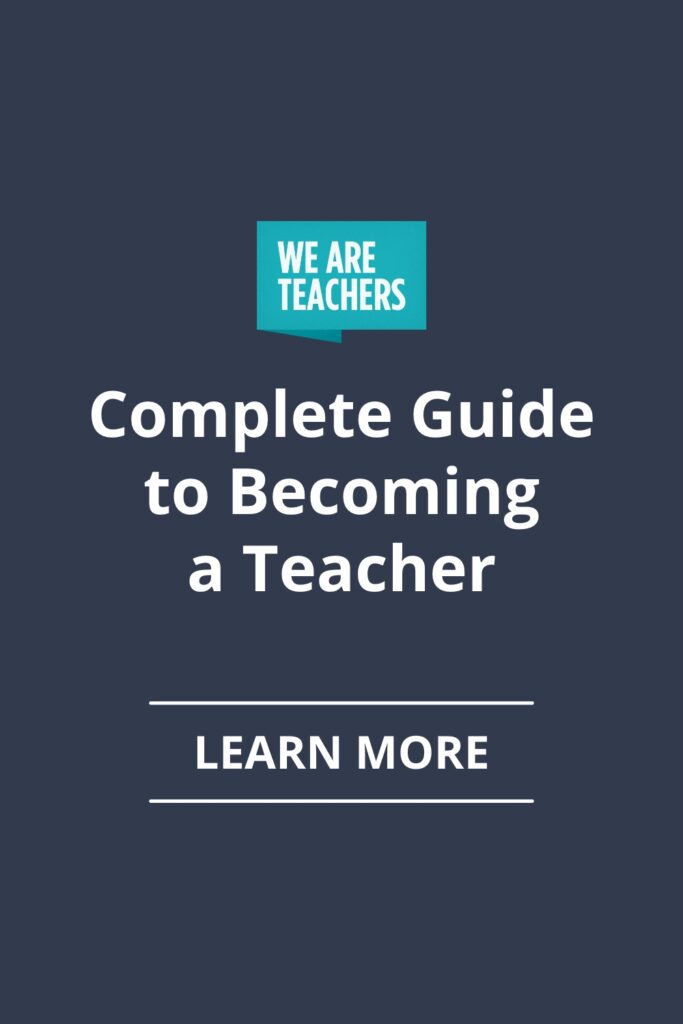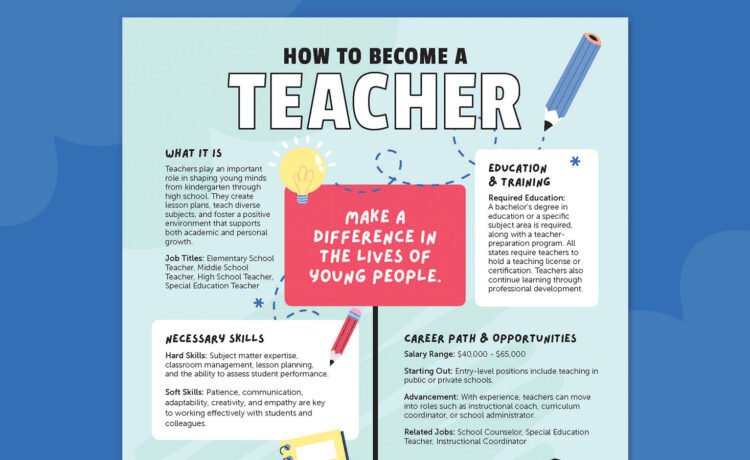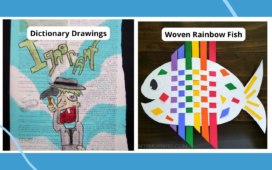Thinking of pursuing a career in teaching? Teachers are needed now more than ever. Learn how to become a teacher, including choosing a college, getting certified, and landing your first job!
Jump to:
Plus, click fill out the form on this page to grab our free printable poster to educate and inspire your students to join the profession.
Is teaching right for you?
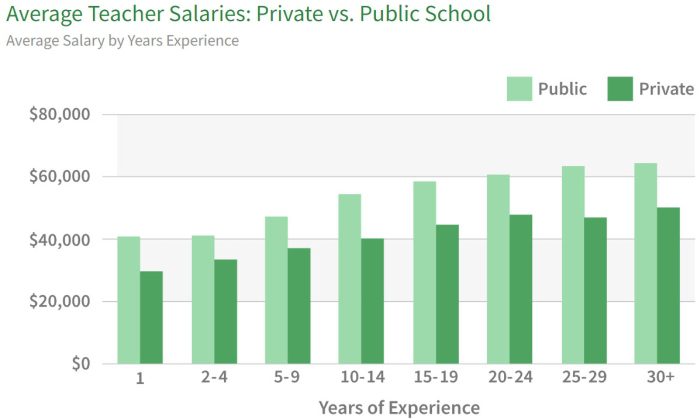
Before you start on a path that could take years of your life, it’s worth spending some time making sure you really want to make this your career. Teaching is one of the most rewarding jobs out there, but it’s also one of the most challenging. Consider these factors:
Salary
According to the NEA, the average teacher salary in 2024 is $69,554. This number, of course, varies by state (see where your state ranks here), location, school, and experience. Starting salaries are generally much lower, sometimes as little as $20K a year.
If you’re thinking that sounds OK since you’ll have your summers off, it’s important to remember that many teachers spend a good portion of their summers on professional development and other school-related activities. And those who don’t often seek out summer jobs to bring in some extra cash.
Workload and Stress
Teacher days rarely begin and end when the bell rings. Though recent years have brought a push for a true 40-hour teacher workweek, you’re much more likely to find yourself coming in early, staying late, and taking work home. It sometimes feels like teaching itself is only a small part of the job, since planning, administrative work, meetings, and more take up a lot of time. Plus, teachers care a great deal about their students’ well-being, adding to their stress load.
Teachers also often have less flexibility in their schedules. While others are planning sunny vacations in the Caribbean at their leisure, teachers are expected to take their vacations during school breaks. Even taking time off to go to the dentist or staying home when you’re sick can feel like a challenge.
So how can you know if teaching is right for you? Before you spend time learning how to become a teacher, start by talking to actual teachers. Ask to shadow them in a classroom, or spend time volunteering as a teacher aide. Learn what teaching truly entails, in the classroom and out. Chances are, you’ll find the rewards worth the challenges, and you’ll be ready to start on your own career path!
Traditional vs. Alternative Paths
Most people follow a traditional path to become a teacher, including:
- Attending a 4-year college program to earn a Bachelor of Science in Education
- Completing a semester (or more) of student teaching
- Passing certification exams and meeting other licensure requirements
Other aspiring teachers may already have a college degree but want to switch careers. The alternative path to become a teacher might include:
- Taking required college courses in pedagogy and other education topics
- Passing certification exams and meeting other licensure requirements
All of these requirements vary by state and type of school. Be sure to verify your state and desired school district’s requirements.
Earning Your College Degree
Whether you enter straight out of high school or earn your degree later in life, here are some tips for the college years.
Choosing and Applying to a College Program
Be sure to choose a program that’s well respected and accredited by the state. Explore their complete program, including how much actual classroom experience you’ll gain before your graduate.
Tip: If you’re planning to teach in a different state than you currently live in, consider attending a college program in that state to ensure you’ll meet all the requirements when you finish.
Paying for College
A college education is definitely an investment. Learn how to pay the bills while you learn.
Surviving Student Teaching
Spending time in the classroom as a “real teacher” is both exciting and terrifying. The important thing is to make the most of your time, asking lots of questions and being open to all the feedback you’ll receive. We’ve got tips from real teachers here for making your student-teacher time really count.
Wondering if you’re getting a quality experience? Look for these elements:
- Co-teaching: Your sponsor teacher should ease you into the experience, spending time co-teaching with you. Learn more about co-teaching here.
- Planning and paperwork: It’s important to learn how to complete lesson plans, fill out paperwork, and handle the other administrative stuff teachers do every day.
- Parent interaction: Whether it’s making phone calls, participating in conferences, or answering emails, be sure you’re getting some experience interacting with parents.
- Independent teaching: By the end of your time as a student teacher, you should be handling a full class day, start to finish. Your sponsor teacher will be in the background, ready to help, but mostly standing by to let you do the job.
- Coaching and feedback: Ideally, you and your sponsor teacher should spend some time every day going over your successes and challenges. Set measurable goals (teachers are experts at these!) and track your growth.
If you feel like your experience is lacking, don’t be afraid to speak up! Talk to your sponsor teacher about what you’re looking for. If they’re unable or unwilling to help, consult your college advisor for advice.
Getting Certified
Every single U.S. state requires teacher certification or licensure. These requirements are completely different in each one, though, so do your research. Start with our complete guide to teacher certification exams in every state.
If you’re following the traditional path to become a teacher, your college program will walk you through the steps. They’ll help you schedule your exams (many offer them on-site). Teacher programs also help you determine other requirements, like background checks and fingerprinting. Be prepared for the costs involved in all of these requirements, which are almost always the responsibility of the applicant.
For those switching careers to teaching without attending a college program, most of the licensure or certification requirements are usually the same, including passing required exams. It’s important to check with your state’s board or department of education to learn what you’ll need to do.
Finally, be aware that many states initially issue provisional certificates or licenses. You’ll need to complete classroom hours and possibly continuing education credits to earn your professional license. And in most cases, you’ll have to follow through with more continuing education credits (sometimes at your own expense) to keep your license or certificate current throughout your career.
Landing a Teaching Job
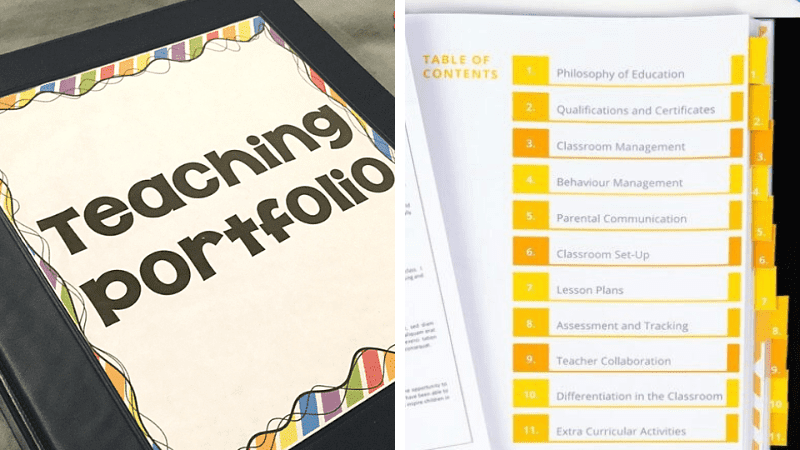
With that teacher certificate or license in hand, you’re ready to find your first job! Fortunately, we’ve got lots of advice to help you out.
Building a Teacher Portfolio and Resume
Mastering the Job Hunt
Nailing the Teacher Interview
Get your free printable teaching career exploration poster
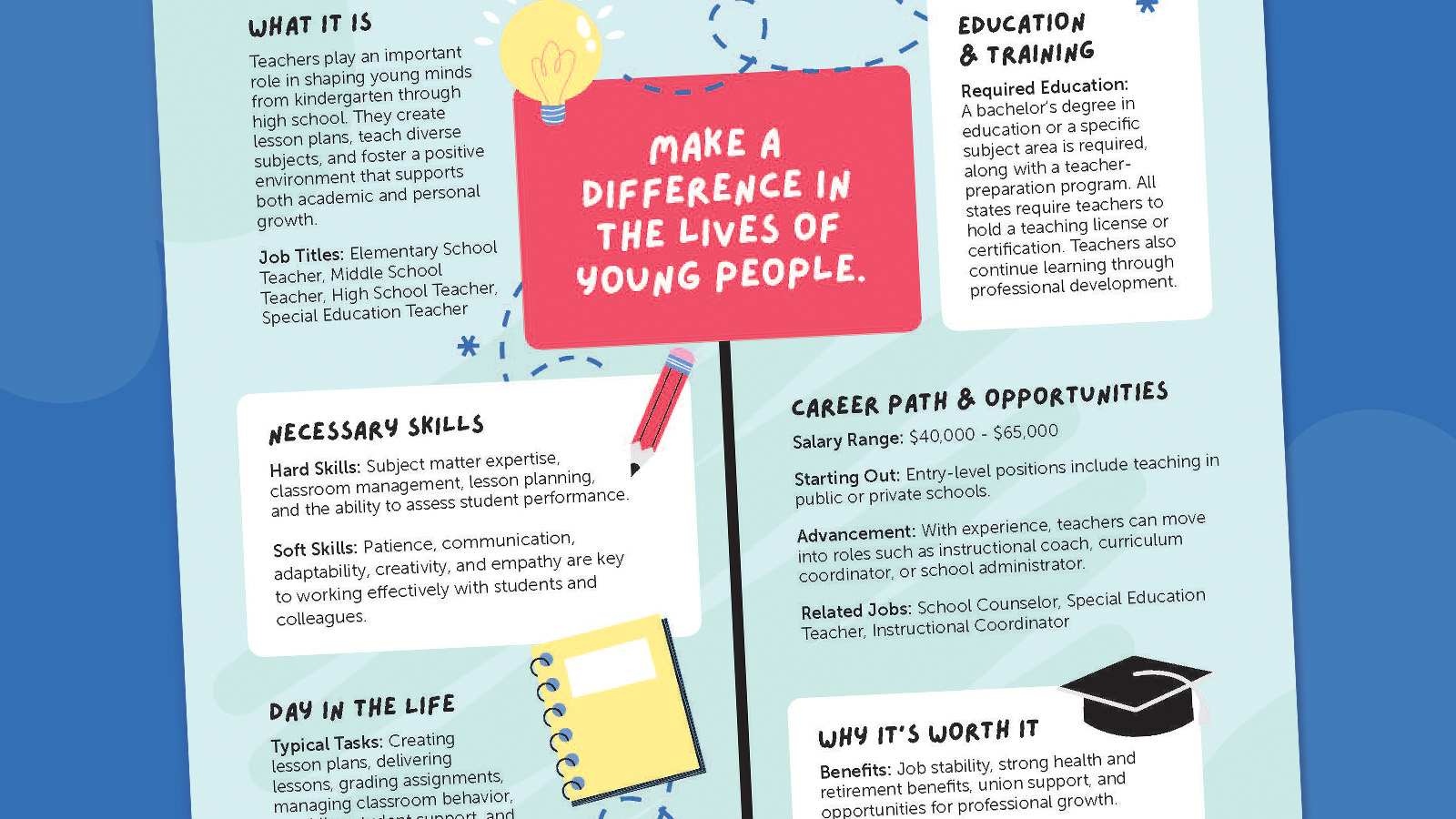
Click the button below to get a free printable poster that explains the necessary skills needed and opportunities available for students who are interested in becoming a teacher.
Have more questions about how to become a teacher? Check out our career advice page, with dozens more articles to explore!
Plus, check out The Big List of Teacher Discounts and Perks.
